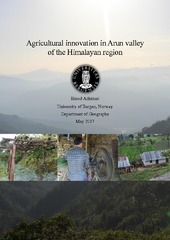| dc.description.abstract | Majority of subsistence farmers in the Himalayan region have been suffering from several problems, which emerged due to social and environmental changes. Scientific studies have already predicted more serious and unpredictable production situation in coming days. In recent times, many academic and non-academic researchers have advocated agricultural innovation as a vital strategy to cope with those problems as well as to face the unpredictable production condition. Therefore, it is important to explore the circumstances that influence the occurrence of agricultural innovations. This thesis assumes that the frequencies of actual innovations are an index of farmers’ innovative capacity. With this assumption, it attempts to make an investigation into the farming practices in Arun valley area of the Himalayan region particularly focusing on mapping innovative practices and analyzing the influencing factors as well as actors of farmers’ innovative capacity. On the conceptual level, it attempts to conceptualize innovative capacity as adaptive ability. The empirical evidences for this thesis have been produced from eight weeks fieldwork in 2016 employing household survey (n=50), group discussions (n=4), key informant interviews (n=10) in two different villages: Majuwa (subsistence-oriented) and Aahale (marketoriented). Innovation system approach has been applied as a theoretical framework and data analysis has been based on the integrated innovation system model, which has been designed by integrating the concept of ‘innovation system’ and ‘innovative place’. The result from comparative case analysis between two villages shows that more innovative practices have been emerged in Aahale than Majuwa during last ten years’ duration. Higher frequency of innovativeness has been identified mainly in off-season vegetable and livestock sectors in Aahale. In the both sectors, interconnected nature in innovation adoption has been observed in which the first adoption itself has become an inducement to the next. Therefore, based on the assumption, it has been revealed that Aahale village has higher degree of innovative capacity than the Majuwa village. Concerning the influencing factors and actors, it has been found that wide and various institutional associations, efficient governmental supports, good market access, sufficient water availability, limited labour migration and less impact of sociocultural barriers are the major enablers of farmers’ innovative capacity and innovative practices in Aahale village. The lack of these supporting factors and actors and high impact of social-cultural barriers have enacted as impediments of innovative capacity and innovative practices in Majuwa. It has been concluded that farmers’ innovative capacity can be raised through promoting multiple factors and actors not through a single or specific factor and actor. While taking into consideration the adaptive ability in multiple challenges and uncertain future, it can be said that innovative practices such as adoption of hybrid crops, higher breed animal varieties and use of modern technology tend to increase productivity and profitability of agriculture. It could raise the farmer’ well-being and reduce the poverty but not all the innovative practices and modification necessarily increase the adaptive capacity to climatic and other uncertainties. It essentially depends on the specific context and circumstances of the farmers’ household, community or country. | en_US |
